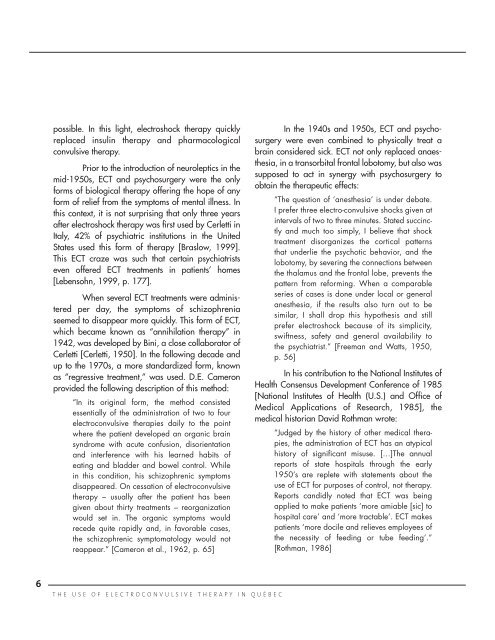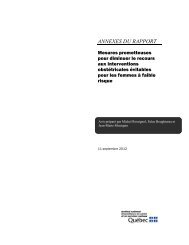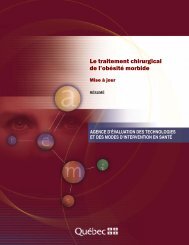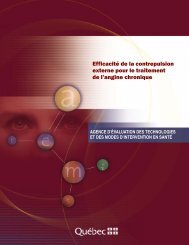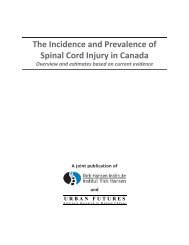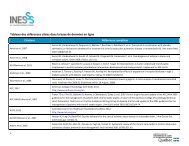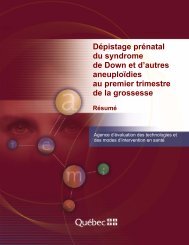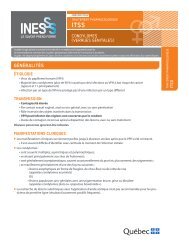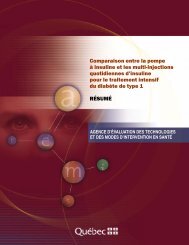The use of electroconvulsive therapy in Quebec - INESSS
The use of electroconvulsive therapy in Quebec - INESSS
The use of electroconvulsive therapy in Quebec - INESSS
You also want an ePaper? Increase the reach of your titles
YUMPU automatically turns print PDFs into web optimized ePapers that Google loves.
6<br />
possible. In this light, electroshock <strong>therapy</strong> quickly<br />
replaced <strong>in</strong>sul<strong>in</strong> <strong>therapy</strong> and pharmacological<br />
convulsive <strong>therapy</strong>.<br />
Prior to the <strong>in</strong>troduction <strong>of</strong> neuroleptics <strong>in</strong> the<br />
mid-1950s, ECT and psychosurgery were the only<br />
forms <strong>of</strong> biological <strong>therapy</strong> <strong>of</strong>fer<strong>in</strong>g the hope <strong>of</strong> any<br />
form <strong>of</strong> relief from the symptoms <strong>of</strong> mental illness. In<br />
this context, it is not surpris<strong>in</strong>g that only three years<br />
after electroshock <strong>therapy</strong> was first <strong>use</strong>d by Cerletti <strong>in</strong><br />
Italy, 42% <strong>of</strong> psychiatric <strong>in</strong>stitutions <strong>in</strong> the United<br />
States <strong>use</strong>d this form <strong>of</strong> <strong>therapy</strong> [Braslow, 1999].<br />
This ECT craze was such that certa<strong>in</strong> psychiatrists<br />
even <strong>of</strong>fered ECT treatments <strong>in</strong> patients’ homes<br />
[Lebensohn, 1999, p. 177].<br />
When several ECT treatments were adm<strong>in</strong>istered<br />
per day, the symptoms <strong>of</strong> schizophrenia<br />
seemed to disappear more quickly. This form <strong>of</strong> ECT,<br />
which became known as “annihilation <strong>therapy</strong>” <strong>in</strong><br />
1942, was developed by B<strong>in</strong>i, a close collaborator <strong>of</strong><br />
Cerletti [Cerletti, 1950]. In the follow<strong>in</strong>g decade and<br />
up to the 1970s, a more standardized form, known<br />
as “regressive treatment,” was <strong>use</strong>d. D.E. Cameron<br />
provided the follow<strong>in</strong>g description <strong>of</strong> this method:<br />
“In its orig<strong>in</strong>al form, the method consisted<br />
essentially <strong>of</strong> the adm<strong>in</strong>istration <strong>of</strong> two to four<br />
<strong>electroconvulsive</strong> therapies daily to the po<strong>in</strong>t<br />
where the patient developed an organic bra<strong>in</strong><br />
syndrome with acute confusion, disorientation<br />
and <strong>in</strong>terference with his learned habits <strong>of</strong><br />
eat<strong>in</strong>g and bladder and bowel control. While<br />
<strong>in</strong> this condition, his schizophrenic symptoms<br />
disappeared. On cessation <strong>of</strong> <strong>electroconvulsive</strong><br />
<strong>therapy</strong> – usually after the patient has been<br />
given about thirty treatments – reorganization<br />
would set <strong>in</strong>. <strong>The</strong> organic symptoms would<br />
recede quite rapidly and, <strong>in</strong> favorable cases,<br />
the schizophrenic symptomatology would not<br />
reappear.” [Cameron et al., 1962, p. 65]<br />
THE USE OF ELECTROCONVULSIVE THERAPY IN QUÉBEC<br />
In the 1940s and 1950s, ECT and psychosurgery<br />
were even comb<strong>in</strong>ed to physically treat a<br />
bra<strong>in</strong> considered sick. ECT not only replaced anaesthesia,<br />
<strong>in</strong> a transorbital frontal lobotomy, but also was<br />
supposed to act <strong>in</strong> synergy with psychosurgery to<br />
obta<strong>in</strong> the therapeutic effects:<br />
“<strong>The</strong> question <strong>of</strong> ‘anesthesia’ is under debate.<br />
I prefer three electro-convulsive shocks given at<br />
<strong>in</strong>tervals <strong>of</strong> two to three m<strong>in</strong>utes. Stated succ<strong>in</strong>ctly<br />
and much too simply, I believe that shock<br />
treatment disorganizes the cortical patterns<br />
that underlie the psychotic behavior, and the<br />
lobotomy, by sever<strong>in</strong>g the connections between<br />
the thalamus and the frontal lobe, prevents the<br />
pattern from reform<strong>in</strong>g. When a comparable<br />
series <strong>of</strong> cases is done under local or general<br />
anesthesia, if the results also turn out to be<br />
similar, I shall drop this hypothesis and still<br />
prefer electroshock beca<strong>use</strong> <strong>of</strong> its simplicity,<br />
swiftness, safety and general availability to<br />
the psychiatrist.” [Freeman and Watts, 1950,<br />
p. 56]<br />
In his contribution to the National Institutes <strong>of</strong><br />
Health Consensus Development Conference <strong>of</strong> 1985<br />
[National Institutes <strong>of</strong> Health (U.S.) and Office <strong>of</strong><br />
Medical Applications <strong>of</strong> Research, 1985], the<br />
medical historian David Rothman wrote:<br />
“Judged by the history <strong>of</strong> other medical therapies,<br />
the adm<strong>in</strong>istration <strong>of</strong> ECT has an atypical<br />
history <strong>of</strong> significant mis<strong>use</strong>. […]<strong>The</strong> annual<br />
reports <strong>of</strong> state hospitals through the early<br />
1950’s are replete with statements about the<br />
<strong>use</strong> <strong>of</strong> ECT for purposes <strong>of</strong> control, not <strong>therapy</strong>.<br />
Reports candidly noted that ECT was be<strong>in</strong>g<br />
applied to make patients ‘more amiable [sic] to<br />
hospital care’ and ‘more tractable’. ECT makes<br />
patients ‘more docile and relieves employees <strong>of</strong><br />
the necessity <strong>of</strong> feed<strong>in</strong>g or tube feed<strong>in</strong>g’.”<br />
[Rothman, 1986]


